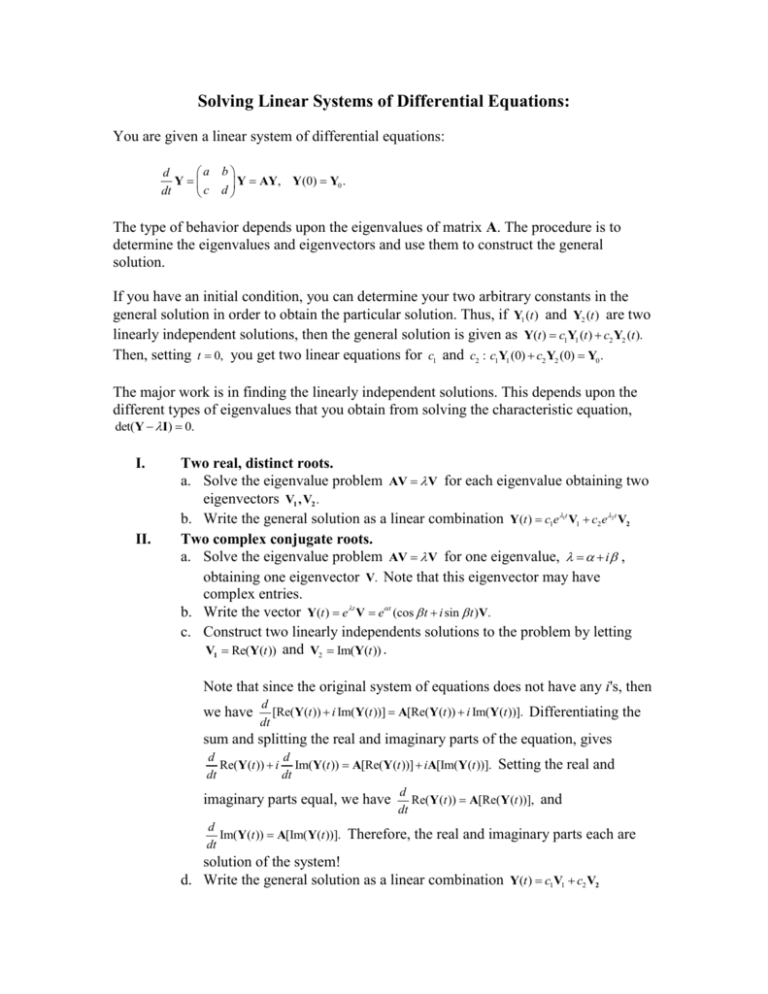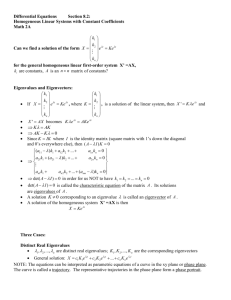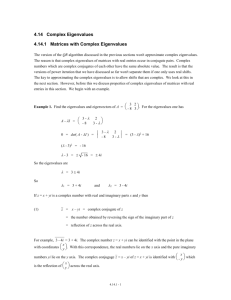Solving Linear Systems - People Server at UNCW
advertisement

Solving Linear Systems of Differential Equations: You are given a linear system of differential equations: a b d Y Y AY, Y(0) Y0 . dt c d The type of behavior depends upon the eigenvalues of matrix A. The procedure is to determine the eigenvalues and eigenvectors and use them to construct the general solution. If you have an initial condition, you can determine your two arbitrary constants in the general solution in order to obtain the particular solution. Thus, if Y1 (t ) and Y2 (t ) are two linearly independent solutions, then the general solution is given as Y(t ) c1Y1 (t ) c2 Y2 (t ). Then, setting t 0, you get two linear equations for c1 and c2 : c1Y1 (0) c2 Y2 (0) Y0 . The major work is in finding the linearly independent solutions. This depends upon the different types of eigenvalues that you obtain from solving the characteristic equation, det(Y I) 0. I. Two real, distinct roots. a. Solve the eigenvalue problem AV V for each eigenvalue obtaining two eigenvectors V1 , V2 . b. Write the general solution as a linear combination Y(t ) c1e t V1 c2 e t V2 Two complex conjugate roots. a. Solve the eigenvalue problem AV V for one eigenvalue, i , obtaining one eigenvector V. Note that this eigenvector may have complex entries. b. Write the vector Y(t ) et V e t (cos t i sin t )V. c. Construct two linearly independents solutions to the problem by letting V1 Re(Y(t )) and V2 Im(Y(t )) . 1 II. 2 Note that since the original system of equations does not have any i's, then we have d [Re(Y(t )) i Im(Y(t ))] A[Re(Y(t )) i Im(Y(t ))]. dt Differentiating the sum and splitting the real and imaginary parts of the equation, gives d d Re(Y(t )) i Im(Y(t )) A[Re(Y(t ))] iA[Im(Y(t ))]. Setting the real and dt dt d imaginary parts equal, we have Re(Y(t )) A[Re(Y(t ))], and dt d Im(Y(t )) A[Im( Y(t ))]. Therefore, the real and imaginary parts each are dt solution of the system! d. Write the general solution as a linear combination Y(t ) c1V1 c2 V2 III. IV. One Repeated Root a. Solve the eigenvalue problem AV V for the one eigenvalue obtaining the first eigenvector V1 . b. Solve the eigenvalue problem AV2 V2 V1 for V2 . c. The general solution is then given by Y(t ) c1et V1 c2 et (V2 tV1 ) . Examples 4 2 . 3 3 a. A 0 4 2 3 3 Eigenvalues: 0 (4 )(3 ) 6 Thus, 1, 6. 0 7 6 0 ( 1)( 6) 2 Eigenvectors: 1: 6: 4 2 v1 v1 3 3 v2 v2 3 2 v1 0 3 2 v2 0 v1 4 2 v1 6 3 3 v2 v2 2 2 v1 0 3 3 v2 0 v 2 v 1 3v1 2v2 0, 1 . 2v1 2v2 0, 1 . v2 3 v2 1 Y(t ) c1e1t V1 c2 e2t V2 2 6 t 1 c2 e 3 1 General Solution: Y(t ) c1et 2c et c e6t 1 t 2 6t . 3c1e c2 e 3 5 b. A . 1 1 0 Eigenvalues: 3 1 5 1 0 (3 )( 1 ) 6 0 2 2 2 (2) 4 4(1)(2) 1 i. 2 Thus, 1 i,1 i. Eigenvectors: 1 i : v1 3 5 v1 (1 i ) 1 1 v2 v2 5 v1 0 2i 2 i v2 0 1 v 2i (2 i )v1 5v2 0, 1 . v2 1 Complex Solution: 2i (1 i ) t 2 i et e 1 1 2i et (cos t i sin t ) 1 (2 i )(cos t i sin t ) et cos t i sin t (2 cos t sin t ) i (cos t 2sin t ) et cos t i sin t 2 cos t sin t cos t 2sin t t et ie . cos t sin t General Solution: 2 cos t sin t t cos t 2sin t Y(t ) c1et c2 e cos t sin t c (2 cos t sin t ) c (cos t 2sin t ) 2 et 1 . c cos t c sin t 1 2 2c1 c2 t 2c2 c1 e sin t . c1 c2 Note: This can be rewritten as Y(t ) et cos t 7 1 . 9 1 c. A 0 7 1 9 1 0 (7 )(1 ) 9 Eigenvalues: 0 2 8 16 0 ( 4) . 2 Thus, 4. Eigenvectors: 4: v1 7 1 v1 4 9 1 v2 v2 3 1 v1 0 9 3 v2 0 v 1 3v1 v2 0, 1 . v2 3 Second Linearly Independent Solution: Solve AV2 V2 V1 7 1 u1 u1 1 4 9 1 u2 u2 3 3 1 u1 1 9 3 u2 3 3u1 u2 1 u1 1 . 9u1 3u2 3 u2 2 General Solution: Y (t ) c1et V1 c2 e t (V2 tV1 ) 1 1 1 Y (t ) c1e 4t c2 e 4t t 3 2 3 c c (1 t ) e 4t 1 2 . 3c1 c2 (2 3t )









